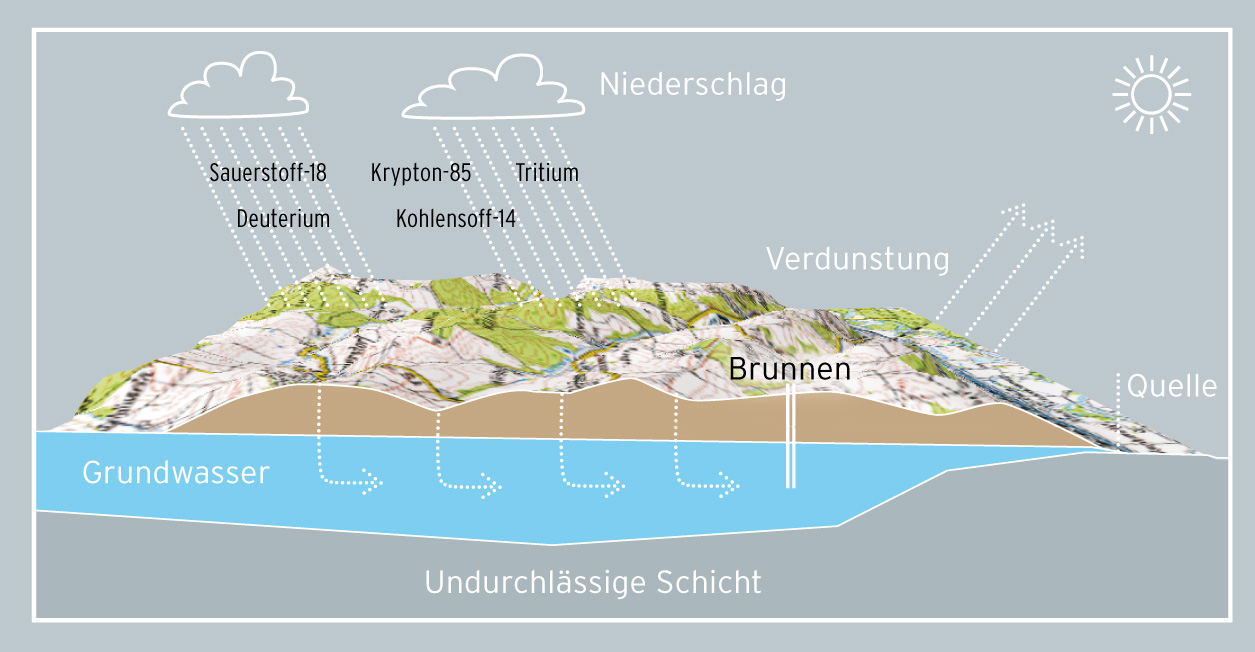Isotope Hydrology
Groundwater tracers move from the atmosphere to the subsurface via precipitation. From the concentrations present there, the time of groundwater formation can be calculated using tracer-specific entry functions.
Clean groundwater is a commodity that requires a great deal of effort to protect and manage. Integrity and purity controls will guarantee the high quality of our drinking water. In order to ensure the security of supply, the age of the pumped groundwater must be known, as well as the mixing proportions of groundwater from different aquifer layers. Isodetect therefore analyzes indicator substances (tracers) that refer to certain periods of groundwater formation. The investigations serve to evaluate drinking water protection areas and for the quality assurance of drinking water wells.
We analyze
- stable and radiogenic water isotopes (2H, 18O, tritium)< /strong>
- Tracer for young groundwater (FKCW, SF6, 3He, 85< /sup>Kr, sweeteners)
- Tracer for old groundwater (14C, 13C, 36Cl, 39Ar)
- different groundwater flow models
- Radioisotopes
- ingredients relevant to drinking water
- Sulfate, nitrate, nitrite and ammonium isotopes
We rate
- Protection of aquifers from contamination (early warning system)
- the construction quality of drinking water wells
- Age and origin of groundwater
- Mixing ratios of premodern and young groundwater
- Bank filtration of river and surface water
- Health risk from radioisotopes in drinking water
- Resource suitability of deep groundwater (geothermal energy, mineral springs)
- Input sources and the degradation of nitrate or ammonium
A groundwater sample from a homogeneously flowing aquifer contains different water layers, which can often have very different ages.
Dating of groundwater
The age of groundwater is a measure of the cleaning or filtering effect of the geological subsoil and thus an indicator of drinking water quality. Groundwater forms from precipitation, which immediately seeps into the subsoil. However, it can also occur with a delay as a result of preceding seepage from surface water.
Depending on the permeability of soil and the distance that precipitation has to seep through the unsaturated soil, the water requires different time periods before it reaches an aquifer. There it mixes with often very old water already present underground. Water molecules that penetrate deep into the groundwater body usually have a much longer travel time than molecules that arrive further upwards.
Because precipitation of many years is mixed in groundwater, it is not possible to state the exact age of a groundwater sample. One speaks of a mean residence time of the various mixed groundwater flow threads. Models such as the piston flow model, the dispersion model or the exponential model mathematically simulate the mixing processes of groundwater bodies with different levels of complexity. They can be used to model the mean flow time (i.e. the “age”) of the water by looking for the best possible match between the mixing scenarios and the isotopic data.


